|
|
|
Sort Order |
|
|
|
Items / Page
|
|
|
|
|
|
|
| Srl | Item |
| 1 |
ID:
132644


|
|
|
|
|
| Publication |
2014.
|
| Summary/Abstract |
This paper explores the causal relationship between economic growth, trade openness and energy consumption using data of 15 Asian countries. The study covers the period of 1980-2011. We have applied panel cointegration and causality approaches to examine the long-run and causal relationship between variables.
Empirical results confirm the presence of cointegration between variables. The impact of economic growth and trade openness on energy consumption is found to be positive. The panel Granger causality analysis reveals the bidirectional causality between economic growth and energy consumption, trade openness and energy consumption.
|
|
|
|
|
|
|
|
|
|
|
|
|
|
|
|
| 2 |
ID:
192237
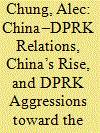

|
|
|
|
|
| Summary/Abstract |
This study investigates, using statistical analysis and case evidence, whether cooperative China–DPRK relations or China’s rise influence the DPRK to act more aggressively toward the ROK–U.S. Statistically, amicable China–DPRK ties have a positive association with the number of DPRK’s aggressive actions toward the ROK–U.S. The increase in China–DPRK’s material capability relative to that of the ROK–U.S. also positively affected this number. These findings are further supported through case evidence: China’s stance toward the DPRK before and after the sinking of the Cheonan in 2010, and the THAAD incident between the DPRK’s fourth and fifth nuclear tests in 2016.
|
|
|
|
|
|
|
|
|
|
|
|
|
|
|
|
| 3 |
ID:
132215
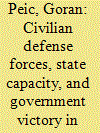

|
|
|
|
|
| Publication |
2014.
|
| Summary/Abstract |
Given the onset of a violent rebellion by an armed non-state group, how do states re-establish intra-state peace and hence fulfill their basic function as providers of internal security? In this article I argue that one way governments perform this core function is by recruiting non-combatants into local self-defense units called civilian defense forces (CDFs). By providing for local security, leveraging their superior local knowledge, and provoking insurgent reprisals against civilians, CDF units facilitate the influx of tactical intelligence as well as isolate insurgents from non-combatant populations physically as well as politically. Consistent with the argument, statistical analyses of two different cross-national data sets of insurgencies from 1944 to 2006 reveal that a state is 53 percent more likely to vanquish a guerrilla threat if the incumbent deploys CDFs. The analyses also cast doubt on a recent claim in the literature that incumbent force mechanization adversely affects the states' ability to counter insurgent threats. Given that CDF deployment is a more easily manipulable variable than most other elements of state power, CDFs appear to be an effective instrument of counterinsurgency deserving of further academic and policy attention.
|
|
|
|
|
|
|
|
|
|
|
|
|
|
|
|
| 4 |
ID:
132321
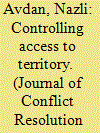

|
|
|
|
|
| Publication |
2014.
|
| Summary/Abstract |
Previous scholarship has largely failed to address the effect of economic interdependence on issue areas other than interstate conflict. This study seeks to redress this lacuna by focusing on states' visa policies and examining the impact of trade and capital interdependence in the context of transnational terrorism. The article argues that economic ties affect visa policies through a reconfiguration of preferences and the opportunity costs of economic loss and by tempering the impact of terrorism. To support this claim, the study conducts statistical analysis using directed dyad data on the visa policies of 207 states and independent political units. The article shows that the impact of economic interdependence is contingent on whether states are directly targeted in attacks of terrorism or face indirect threats from global terror. The study finds that economic incentives overwhelm security concerns when threats are indirect but have relatively limited influence, given threats against a state's own citizens or territory.
|
|
|
|
|
|
|
|
|
|
|
|
|
|
|
|
| 5 |
ID:
112394


|
|
|
|
|
| Publication |
2012.
|
| Summary/Abstract |
This article presents the results of an empirical survey of Slovenian defence enterprises focusing on three segmented geographic market outlets: the domestic market, the other European Union (EU-26) markets and the global markets. In the enterprise surveys are included around two-thirds of the domestic defence enterprises of different sizes and activities. The Slovenian defence enterprises by production, supply-in-return, subcontracting, middleman and trader activities in the defence marketing chains are mostly specializing towards the businesses on the domestic market. Rare enterprises are specialized exclusively for activities on the EU-26 markets and the global markets.
|
|
|
|
|
|
|
|
|
|
|
|
|
|
|
|
| 6 |
ID:
132651


|
|
|
|
|
| Publication |
2014.
|
| Summary/Abstract |
This paper uses Q methodology to reveal stakeholder perceptions on how best to address energy issues in Africa. We sampled a group of stakeholders involved in various energy sub-sectors to uncover perspectives on how to achieve and promote access to modern energy, energy efficiency and renewable energy in Africa, whether the perceptions could be correlated to educational or geographical background and implications such patterns could have on policies and current dialogues.
We found that all stakeholders agree on the need to prioritise sustainability but had different views on how to achieve sustainable energy for all in Africa, depending on the relevance given to each energy driver. Stakeholders could be categorised into four groups: (I) preference of large-scale high-impact projects; (II) supporters of targeted sectoral solutions with preference for small-scale technology and microfinance; (III) supporters of centralised solutions with preference for grid extension, and (IV) supporters of local entrepreneurship with scepticism about centralised solutions. The results show that differences in stakeholders' perceptions can be associated with respondents' educational but not geographical background. This implies that dialogues on energy in Africa should focus on inter-disciplinary understanding while further examining the trans-continent consensus that appears to have been established.
|
|
|
|
|
|
|
|
|
|
|
|
|
|
|
|
| 7 |
ID:
092341
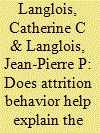

|
|
|
|
|
| Publication |
2009.
|
| Summary/Abstract |
Does attrition behavior, defined as waiting for the other side to give in despite the costs of delay, help explain the duration of interstate wars? To answer this question we develop a war and bargaining model that integrates a dynamic progression of the war and allows the rivals to make offers at any time of their choosing while they fight. The model predicts that, in equilibrium, states choose to fight without making significant offers in the hope that the other side will give in to outstanding demands. The model also predicts that each side's flow cost of war increases with the probability that the other side gives in to its demands. This is the testable consequence of attrition behavior. Our statistical analysis suggests that both challenger and defender include attrition behavior in their conduct of warfare, and that this behavioral element significantly affects the duration of interstate wars.
|
|
|
|
|
|
|
|
|
|
|
|
|
|
|
|
| 8 |
ID:
132736


|
|
|
|
|
| Publication |
2014.
|
| Summary/Abstract |
Are preferential trade agreements (PTAs) in the Asia-Pacific region merely a political phenomenon with no economic basis, as some critics say? I challenge this interpretation; in this article I present an explanatory model based on intra-industry trade to indicate what economic interests should drive Japanese and South Korean PTAs with ASEAN partners, and derive specific predictions. An analysis of the actual tariff barrier elimination in the agreements suggests important, but highly specific, economic benefits. First, preference margins are substantively greater for intra-industry trade, and second, intra-industry trade is much less likely to be excluded from tariff reductions when imported into Japan or South Korea. This indicates that PTAs help firms specialize their production throughout the region, and provides an economic rationale for these agreements. A qualitative case study of the Japan-Malaysia PTA and a statistical analysis of tariff liberalization in the PTAs of Japan and South Korea with the ASEAN countries support this view.
|
|
|
|
|
|
|
|
|
|
|
|
|
|
|
|
| 9 |
ID:
112263
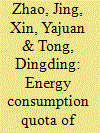

|
|
|
|
|
| Publication |
2012.
|
| Summary/Abstract |
The establishment of building energy consumption quota as a comprehensive indicator used to evaluate the actual energy consumption level is an important measure for promoting the development of building energy efficiency. This paper focused on the determination method of the quota, and firstly introduced the procedure of establishing energy consumption quota of public buildings including four important parts: collecting data, classifying and calculating EUIs, standardizing EUIs, determining the measure method of central tendency. The paper also illustrated the standardization process of EUI by actual calculation based on the samples of 10 commercial buildings and 19 hotel buildings. According to the analysis of the frequency distribution of standardized EUIs of sample buildings and combining the characteristics of each measure method of central tendency, comprehensive application of mode and percentage rank is selected to be the best method for determining the energy consumption quota of public buildings. Finally the paper gave some policy proposals on energy consumption quota to help achieve the goal of further energy conservation.
|
|
|
|
|
|
|
|
|
|
|
|
|
|
|
|
| 10 |
ID:
127917


|
|
|
|
|
| Publication |
2014.
|
| Summary/Abstract |
Along with climate change and affordability, concerns about energy security are key drivers behind proposals for major energy system change in the UK and numerous other countries. Unlike climate change we know very little about how the public thinks and feels about this aspect of sustainability and energy policy. Beyond engaging critically with conceptual and theoretical discussions, empirical data from two surveys (Cardiff postal survey, N=520; online UK survey, N=499) using a ten item energy security scale are presented and discussed. Here we show that aspects of energy security are certainly of concern to the UK public, with particularly high concern around dependence on fossil fuels/imports and relatively lower expressed concern for actual disruption of energy supply. However public concerns around energy security are only emerging, and likely to change depending on the context in which it is discussed (e.g. in comparison to climate change). In addition, findings from public interviews are used to further contextualise the survey findings, showing unfamiliarity among the UK public with regards to the term "energy security". We discuss implications, and further work that would be useful for understanding public perceptions in more dept
|
|
|
|
|
|
|
|
|
|
|
|
|
|
|
|
| 11 |
ID:
125762
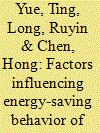

|
|
|
|
|
| Publication |
2013.
|
| Summary/Abstract |
In this research, the willingness of households to adopt different energy-saving behavior has been analyzed, and factors influencing energy-saving behavior in Jiangsu Province, China, have been examined. The study builds on a broad and practical conceptual framework that embraces three types of energy-saving behavior and four dimensions of influencing factors, including socio-demographics, energy-saving awareness, behavioral ability, and situational factors. The empirical results are based on an Internet survey that was sent out to 638 households. The results indicate that socio-demographic characteristics, including age, gender, income level, household structure, and educational background, are all important factors influencing energy-saving behavior. At present, respondents adopt the usage-reduction type of behavior more often than the other two types, which require a greater capacity to pay for energy-efficient products and a higher level of energy-saving awareness. Situational factors have significant positive moderating effects when the variables of behavioral ability and energy-saving awareness act on energy-saving behavior. In addition, the results also show that spatial differences exist among the three regions of Jiangsu Province. Finally, some implications of these results for the design of future incentive policies and measures to encourage energy-saving behavior are presented.
|
|
|
|
|
|
|
|
|
|
|
|
|
|
|
|
| 12 |
ID:
165923
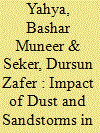

|
|
|
|
|
| Summary/Abstract |
According to many local and international reports, the risk of dust and sandstorms has increased significantly in Iraq, creating serious environmental and social problems. In this study Nineveh province was selected as the study area to investigate the relationship between the increase in such storms and drought expansion. In the study, storm-feeding regions and a probable storm path were detected using remote sensing and Geographic Information System (GIS). Standardized Precipitation Index (SPI) and runoff values were estimated and gathered as supplementary data with rainfall, temperature and storm frequency, where all the data were standardized to make them statistically comparable. Temporal variations analysis and Spearman’s rank correlation techniques were applied to summarize the strength relationships between the storm frequency and the entire dataset. Unusual behaviours were noticed and represented by decreasing runoff values and drought conditions fluctuating between moderate to extreme, where these behaviours were accompanied by an abnormal increase in storm frequency. Reasonable negative relationships equalled - 0.78 for rainfall and - 0.61 for runoff, while positive rank correlations equalled + 0.45 for temperature and + 0.16 for SPI. These results indicate a positive relationship between the storm frequency and increased drought areas, where 2.2% of the territory turned to drought and desert areas during the studied period between 1992 and 2017.
|
|
|
|
|
|
|
|
|
|
|
|
|
|
|
|
| 13 |
ID:
167375
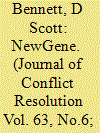

|
|
|
|
|
| Summary/Abstract |
This article introduces NewGene, a complete redesign of the popular EUGene software. Like its predecessor, NewGene is designed to eliminate many of the difficulties commonly involved in constructing large international relations data sets. NewGene is a stand-alone Microsoft Windows and OSx-based program for the construction of annual, monthly, and daily data sets for a variety of decision-making units (e.g., countries, leaders, organizations) used in quantitative studies of international relations. It also provides users the ability to construct units of analysis ranging from monads (e.g., country-year), to dyads (e.g., country1-country2-year), to extra-dyadic observations called k-ads (e.g., country1-country2-year,…, -countryk-year). NewGene’s purpose is to provide a highly flexible platform on which users can construct data sets for international relations research using preloaded data or by incorporating their own data. The software is freely available at http://www.newgenesoftware.org/.
|
|
|
|
|
|
|
|
|
|
|
|
|
|
|
|
| 14 |
ID:
133223
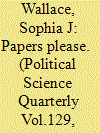

|
|
|
|
|
| Publication |
2014.
|
| Summary/Abstract |
THE QUOTATION ABOVE FROM THE SPONSOR of Arizona's SB 1070, former Senator Russell Pearce, exemplifies the Republican rhetoric focused on the problem of undocumented immigration and border security that has dominated discussions of immigration over the past decade. The negative media coverage and controversy among constituents eventually bubbled into a push to recall Senator Pearce, which was successful in the November 2011 elections.1 Arizona's SB 1070 criminalizes failure to carry proof of legal immigration status as a state misdemeanor; requires the police to determine the immigration status of a person detained in a lawful stop, detention, or arrest if there is a reasonable suspicion that the person might be undocumented; and prohibits local and state officials from limiting or restricting enforcement of federal immigration laws. In essence, the law is broad in its attack on undocumented immigrants and grants substantial power and discretion to the state and local level for enforcing immigration laws.
|
|
|
|
|
|
|
|
|
|
|
|
|
|
|
|
| 15 |
ID:
138298
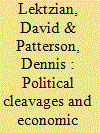

|
|
|
|
|
| Summary/Abstract |
We develop and test a theory, based on the Stolper–Samuelson Theorem, of the effectiveness of sanctions. We treat sanctions as exogenously imposed changes in a country's exposure to international markets. In a country with an open-trade regime, owners and intensive users of the abundant factor of production hold economic and political power. In a country closed to trade, however, economic and political power rests with owners and intensive users of scarce factors. Thus, if real rates of return to the abundant factor decline during sanctions against a trade-open country, or real rates of return to the scarce factor decline during sanctions against a trade-closed country, we expect these economically and politically powerful segments of the targeted country to push hard for policy changes that would bring about an end to sanctions. Statistical analysis of sanctions episodes initiated between 1971 and 2000 provides support for the paper's expectations.
|
|
|
|
|
|
|
|
|
|
|
|
|
|
|
|
| 16 |
ID:
156239
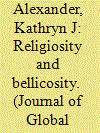

|
|
|
|
|
| Summary/Abstract |
Are states with religiously committed citizens more likely to initiate conflict than states with less committed populations? This article builds upon findings within the literature on American politics that link individuals’ levels of religious commitment to their attitudes about foreign policy, and it tests whether the implications of these findings have cross-national applicability and explanatory power for interstate conflict. Using a novel, robust measure of the proportion of a state's population that is religiously committed, as well as monadic and dyadic statistical models, the analysis finds widespread connections between religious commitment and bellicose state behaviors. The results show that states with more religiously committed populations demonstrate higher propensities for initiating conflict with other states. This relationship is most severe when both states in a dyad have high levels of religious commitment, while it does not appear to be conditioned by whether majorities within the populations of each state ascribe to different religious traditions. This project advances knowledge about both the role of religion in international relations and conditions for interstate conflict, emphasizing the relevance of domestic cultural factors to global politics.
|
|
|
|
|
|
|
|
|
|
|
|
|
|
|
|
| 17 |
ID:
131994
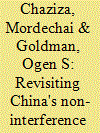

|
|
|
|
|
| Publication |
2014.
|
| Summary/Abstract |
This article evaluates, through statistical analysis, China's foreign policy of non-intervention, and answers the question of whether or not China has kept to its declared policy regarding intrastate wars relative to the other four powers that are permanent members of the UN Security Council. The evidence in this article suggests that the Chinese policy of non-interference was more a declaration than a policy. China significantly lower only from the United States and the USSR/Russia and differs solely in numbers of interventions, their extent, and diversity. Yet China is the only power that has not sent troops to interfere in intrastate wars. The country's share among the powers in supporting actors in intrastate wars is significantly less as time passes, although China exhibited no significantly different trends between the Cold War and the post-Cold War periods. It is, on the contrary, the United States and UK among the powers that have significantly increased their relative share of interference.
|
|
|
|
|
|
|
|
|
|
|
|
|
|
|
|
| 18 |
ID:
042305
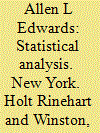

|
|
|
|
|
| Publication |
New York, Holt rinehart and Winston, 1965.
|
| Description |
xii, 234p.
|
|
|
|
|
|
|
|
|
|
|
|
Copies: C:1/I:0,R:0,Q:0
Circulation
| Accession# | Call# | Current Location | Status | Policy | Location |
| 002289 | 519.5354/EDW 002289 | Main | On Shelf | General | |
|
|
|
|
| 19 |
ID:
139984
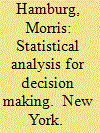

|
|
|
|
|
| Publication |
New York, Harcourt, Brace and world, Inc., 1970.
|
| Description |
xiii, 817p.hbk
|
| Series |
Harbrace Series in Business and Economics
|
| Standard Number |
0155837605
|
|
|
|
|
|
|
|
|
|
|
|
Copies: C:1/I:0,R:0,Q:0
Circulation
| Accession# | Call# | Current Location | Status | Policy | Location |
| 004818 | 658.4033/HAM 004818 | Main | On Shelf | General | |
|
|
|
|
| 20 |
ID:
124328
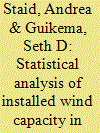

|
|
|
|
|
| Publication |
2013.
|
| Summary/Abstract |
There is a large disparity in the amount of wind power capacity installed in each of the states in the U.S. It is often thought that the different policies of individual state governments are the main reason for these differences, but this may not necessarily be the case. The aim of this paper is to use statistical methods to study the factors that have the most influence on the amount of installed wind capacity in each state. From this analysis, we were able to use these variables to accurately predict the installed wind capacity and to gain insight into the driving factors for wind power development and the reasons behind the differences among states. Using our best model, we find that the most important variables for explaining the amount of wind capacity have to do with the physical and geographic characteristics of the state as opposed to policies in place that favor renewable energy.
|
|
|
|
|
|
|
|
|
|
|
|
|
|
|
|
|
|
|
|
|